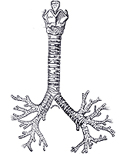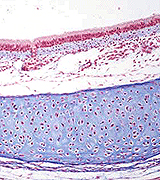 The
trachea (Fig. 17-5) -- conducts air to the two main bronchi,
which are similar to the trachea histologically. Examine the diagram
of trachea and major bronchi. The
trachea (Fig. 17-5) -- conducts air to the two main bronchi,
which are similar to the trachea histologically. Examine the diagram
of trachea and major bronchi.
Examine the longitudinal section of
larynx (slide 7),
and the slide of trachea (slide 140) identifying the cartilage
of the tracheal rings.
- In the respiratory epithelium,
note especially the cilia and the thick basement membrane.
Speculate on the function of
the thick basement membrane in respiratory epithelium?
 What is the function of the
well-developed cilia? What is the function of the
well-developed cilia?
Why do smokers usually find
themselves coughing more than non-smokers?
Examine the H&E-stained transverse
section of trachea (slide 140)
and identify the major layers indicated in Fig. 17-5.
- Note the abundant sero-mucous
glands, the ring of cartilage, and the trachealis muscle on the
posterior side. Examine the respiratory epithelium
carefully.
Why are the trachealis muscle
and the shape of the cartilage rings important?
On to the lung. |